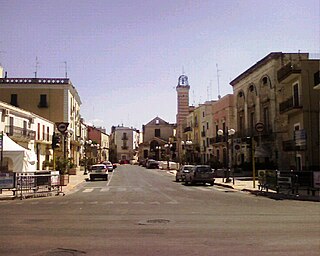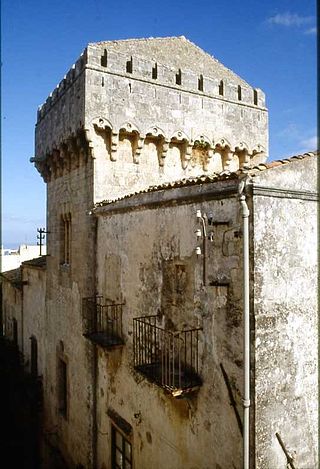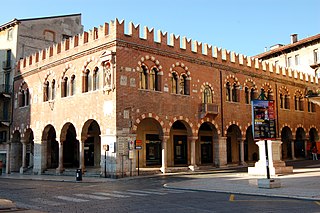
Bitonto is a city and comune in the Metropolitan City of Bari, Italy. It lies to the west of Bari. It is nicknamed the "City of Olives", due to the numerous olive groves surrounding the city.

Piazza dei Cavalieri is a landmark in Pisa, Italy, and the second main square of the city. This square was the political centre in medieval Pisa. After the middle of 16th century the square became the headquarters of the Order of the Knights of St. Stephen. Now it is a centre of education, being the main house of the Scuola Normale di Pisa, a higher learning institution part of the University.

Piazza Armerina is a comune in the province of Enna of the autonomous island region of Sicily, southern Italy.

Acquaviva delle Fonti is a town and comune of 20,446 inhabitants, in the Metropolitan City of Bari, in Apulia, Italy. Acquaviva is famous for its characteristic red onions, which have been awarded the DOP mark. The main monuments are the Palazzo de Mari, the Co-Cathedral of Sant'Eustachio and the ancient village. The town is located on the Murge plateau at an elevation of 300 metres (980 ft) above sea level, and is 26 kilometres (16 mi) from the Adriatic Sea and Bari, which is the biggest city of the region. The Ionian Sea is more than 45 kilometres (28 mi) to the south.

Casamassima is a town and comune of 19,786 inhabitants in the Metropolitan City of Bari, in Apulia, southern Italy. Is also called "The Blue Town". The town is located inland from the Italian coastline, thrives and is built on agriculture, primarily that of wine, olives and almond production. Founded around the seventh and eighth centuries, the village started as a Roman encampment, according to legend.

Modugno is a town and comune of the Metropolitan City of Bari, Apulia, southern Italy.

Altamura Cathedral, dedicated to the Assumption of the Blessed Virgin Mary, is a Roman Catholic cathedral in the city of Altamura, in the Metropolitan City of Bari, Apulia, in southern Italy.

The Casa del Fascio of Como, also called Palazzo Terragni, is a building located in Como, Italy, in the Piazza del Popolo, and it is one of the masterpieces of Italian Modern Architecture. It was designed by Italian architect Giuseppe Terragni (1904-1943). It was inaugurated in 1936 as the local office of the National Fascist Party. After the fall of Fascism in 1945, it was used by the National Liberation Committee Parties and in 1957, it became the headquarters of the local Finance Police, who still occupy it. The building has a square plan and four stories.

The Basilica of San Giovanni Maggiore is a church in Largo San Giovanni Maggiore in central Naples, Italy.

Auberge de Provence is an auberge in Valletta, Malta. It was built in the sixteenth century to house knights of the Order of Saint John from the langue of Provence. It now houses the National Museum of Archaeology.

The Casa dei Cavalieri di Rodi is a building in Rome. Sited in the ruins of the Forum of Augustus, it was built by the Knights Hospitaller at the end of the 13th century and since 1946 has been used by their successors, the Sovereign Military Order of Malta.
Francesco Paolo Masullo, was an Italian singer.

Palazzo De Ballis is a 15th-century historical building of Spanish Gothic architecture; the Tower De Ballis is a part of it. It is located in the town centre of Alcamo, in the province of Trapani.

The Military Corps of the Sovereign Military Hospitaller Order of Saint John of Jerusalem of Rhodes and of Malta, is a voluntary auxiliary body of the Italian Army for health and humanitarian assistance.
The Association of Italian Knights of the Sovereign Military Order of Malta brings together the Knights and Ladies of the Sovereign Military Order of Malta of Italian nationality. It was founded in 1877 in Rome, it is currently based at the Casa dei Cavalieri di Rodi in the Piazza del Grillo, Rome.

The Palazzo del Governatore di Borgo, also called Palazzo delle Prigioni di Borgo, Palazzo del Soldano, or Palazzo dal Pozzo, was a Renaissance palace in Rome, important for artistic and historical reasons. Designed by Antonio da Sangallo the Younger, it was demolished in 1936 for the opening of Via della Conciliazione.

The Casa della Vittoria is a building northwest of the city center of Turin, Piedmont, Italy, considered one of the most interesting examples of residential architecture in a Medieval-revival style in the Piedmontese capital. Located in the district Cit Turin, the Casa della Vittoria is at the center of an area of great architectural interest that contains a high density of Art Nouveau and Gothic Revival buildings, including also the nearby church of San Donato.
The Ricetta di Malta, also known as the Ricetta dei Cavalieri di Malta, is a ruined historic building in Augusta, Sicily. It was built in the 17th century by the Knights Hospitaller as a supply base.





















